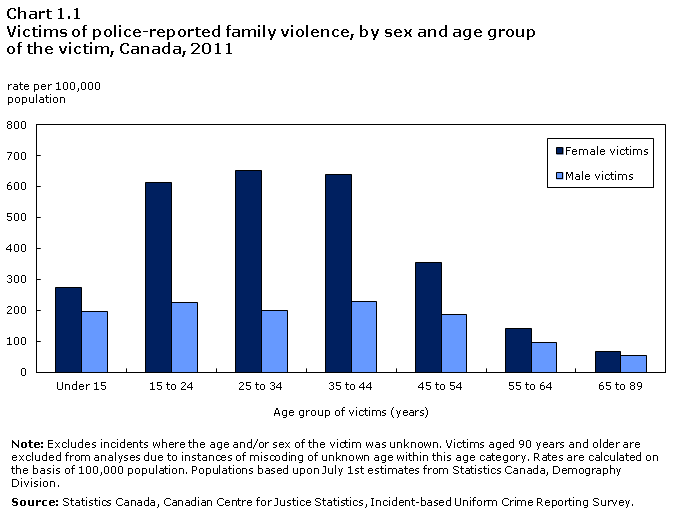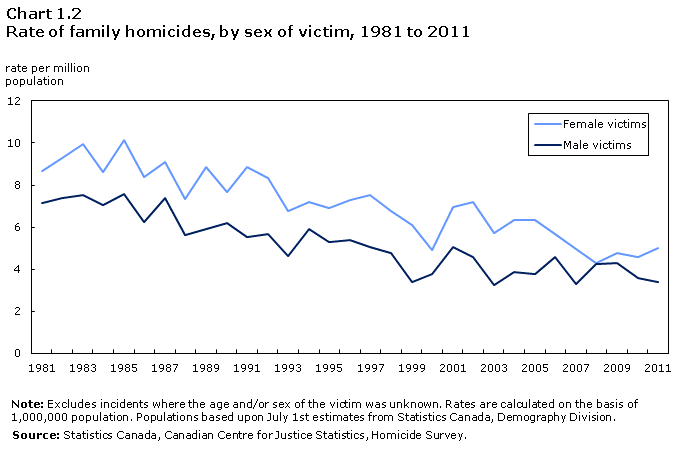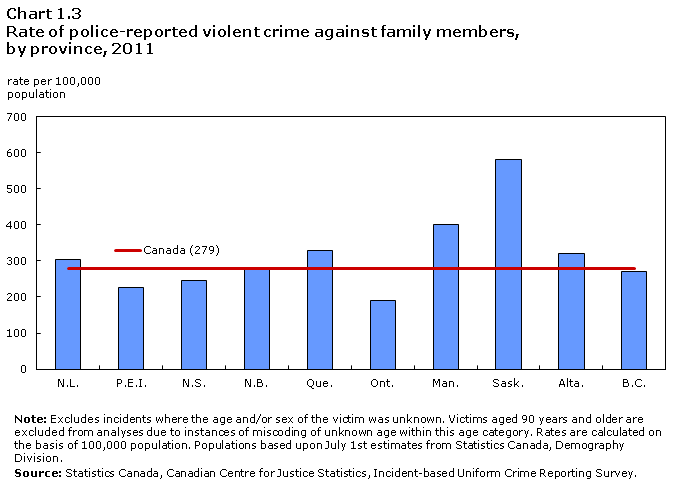Section 1: Overview of family violence
By Maire Sinha
- Defining family violence in Canada
- Measuring family violence in Canada
- Organization of the report
- Overview of family violence in Canada
- Summary
- Detailed data tables
- References
- Notes
Since 1998, as part of the federal Family Violence Initiative,Note 1 Statistics Canada has released an annual report that examines the nature and extent of family violence in Canada. Along with other goals, the Initiative serves to promote public awareness of the risk factors associated with family violence and aims to enhance data collection, analysis, research and evaluation efforts that inform policies and programs.
The annual Juristat article is designed to help monitor changes in family violence over time and identify emerging issues. Accordingly, each report presents trend data on the magnitude of the problem in Canada and profiles a different aspect of family violence. Previous annual reports have focused on such topics as criminal harassment/stalking (2005), criminal justice system responses to family violence (2004), shelters for abused women (2009), and a comparative analysis of family and non-family violence (2010). The special focus of this year's report is the prevalence and nature of family murder-suicides in Canada.
Defining family violence in Canada
Defining family violence is critical to accurately analyzing its prevalence and nature within Canadian society. While there is no universally accepted definition of family violence, two elements must be considered in any definition: the forms of violence to be included and the types of family relationships. Within the Family Violence Initiative, family violence has been conceptualized as "a range of abusive behaviours that occur within relationships based on kinship, intimacy, dependency or trust" (Family Violence Initiative Performance Report, 2008). This definition can encompass physical, sexual, verbal, emotional, and financial victimization, or neglect. Within this article, analysis of violence within the family is primarily based on statistical data that are consistent with Criminal Code definitions.
Identifying the relationships for inclusion in a definition of family violence is also a question of scope. For the purpose of this article, the term 'family' refers to relationships defined through blood, marriage, co-habitation (in the case of common-law partners), foster care, or adoption. While there has been some consideration within the research community towards including dating violence in a definition of family violence due to its similarities with spousal violence, dating violence is not included in a definition of family violence within this report.Note 2 Rather, violence against dating partners is examined alongside spousal violence in the context of intimate partner violence.
Measuring family violence in Canada
There are two main Statistics Canada sources of information used to measure family violence in Canada: police-reported information from the Uniform Crime Reporting (UCR) Survey and the Homicide Survey, and self-reported victimization data from the General Social Survey on Victimization. These data sources yield complementary yet different types of information on violence within families.
Every year, both the UCR Survey and the Homicide Survey collect data on all Criminal Code offences reported to, and substantiated by Canadian police services. These surveys are able to provide trend data and regional level information on family violence, as well as information on the characteristics of victims, accused and incidents.
In addition to police-reported data, estimating the prevalence of violent crime can be done using the General Social Survey (GSS) on Victimization, a self-reported victimization survey. Conducted every five years, this sample survey of Canadians aged 15 years and older captures both crimes that are reported and unreported to the police. In doing so, it is able to shed light on the levels of under-reporting to police. According to the most recent GSS (2009), less than one-third of incidents of violent victimization (29%) came to the attention of police (Perreault and Brennan 2010).
While the GSS is able to describe the range of consequences of victimization and victims' reliance of social supports, it has some disadvantages in estimating the level and nature of family violence. For instance, children under 15 years of age and individuals living in institutions, such as long-term care facilities, are not eligible to participate in the survey. Only official sources of information, such as reports from police, are able to yield information on violence against children under the age of 15, as well as those persons living in institutions. The survey also excludes Canadians who are unwilling or unable to participate in the survey.Note 3
Organization of the report
Using police-reported data, the current report begins by profiling the overall prevalence of family violence in Canada, describing how it has changed over time. Also presented are regional variations and patterns in the nature of police-reported family violence in Canada. Next, the focus section describes the characteristics of family-related murder-suicides, highlighting trends, risk factors related to this form of homicide, the underlying motives, weapons (if any) used to commit the crime, and the characteristics of accused.
In keeping with previous years, the remainder of the report will profile three forms of violence: intimate partner violence (including both spousal and dating violence partners), family violence against children, and family violence against seniors aged 65 years and older.
Overview of family violence in Canada
Over the course of the previous 30 years, there have been substantial changes in the criminal justice system response and social intervention to family violence. Violent acts committed against family members, once considered private matters, are now recognized as serious violent crimes (Bala 2008; Schneider 2007).
While the Criminal Code does not contain separate violent offences based on the relationship of the victim and offender,Note 4 perpetrators of violent acts against family members can be charged with the appropriate criminal offence, such as homicide, assault, sexual assault, or criminal harassment. Further, the Criminal Code considers the abuse of a spouse or child or any position of trust or authority to be an aggravating factor at sentencing.
Other Criminal Code provisions can assist victims of family violence, including the availability of protection orders and the enhancement of testimonial aids for vulnerable victims (Justice Canada n.d.). Beyond the Criminal Code, some provincesNote 5 and all three territories have also adopted civil legislation specific to family violence. These pieces of legislation serve to provide additional supports and protection to victims of family violence.
Procedurally, police, courts, and corrections have also recognized the unique needs of victims and offenders of family violence. Criminal justice initiatives have included changes to policing protocols (such as pro-charging policies), domestic violence investigation units within police services including programs for dating partners, specialized training programs for police and Crown counsel, dedicated domestic violence courts, and family violence treatment interventions within correctional systems (Correctional Services of Canada n.d.; Public Health Agency of Canada 2008).
Victims of family violence represent one-quarter of all violent crime victims
In 2011, police reported nearly 95,000 victims of family violence, representing one-quarter (26%) of all victims of violent crime (Table 1.1). This translates into a family violence rate of 279 victims for every 100,000 individuals in the population.
Most commonly, victims of family violence were in a spousal relationship with the accused, with about half of victims (49%) being currently or previously married to the accused. These victims included those who were or had been in a legal or common-law union. Another 18% of family violence victims were victimized by their parent, 13% by an extended family member, 11% by a sibling and 9% by a child, most often a grown child.
Regardless of the type of family violence, victims were predominantly female. Overall, nearly seven in ten (69%) victims of family violence were female. This disproportionate representation was most pronounced for spousal violence, as 80% of victims were female, but was also evident when the accused was a child (63%), extended family member (58%), parent (57%) and sibling (57%).
Reflecting women's over-representation as spousal violence victims, female victims of family violence tended to fall between the ages of 15 to 44 years (Chart 1.1). On the other hand, for male victims of family violence, rates were similar between all age groups until the age of 55 years, when the rates subsequently drop. At age 55, grown children replace spouses as the most common perpetrator of violence against men aged 55 and older.

Police-reported rates of family violence generally decreasing
In general, monitoring changes in family violence over time can help to identify emerging trends, as well as informing the development and evaluation of programs, policy, criminal legislation, and various initiatives designed to reduce this form of violence. According to police-reported data, there is some indication that violence against family members is declining. Though relatively rare, homicides – often considered a barometer of violent crime overall - have been declining against family members over the previous 30 years (Chart 1.2). In 2011, the rate of family homicides per million was 47% lower than in 1981. This downward trend mirrors patterns in homicide overall and was the case for both female and male victims of family homicide.

Reported incidents of non-lethal forms of family violence have also seen decreases in recent years. For instance, the rate of attempted murders dropped 10% between 2009 and 2011 (Table 1.2). Smaller drops were also reported over this time period for physical assaults (levels 1, 2, and 3) and sexual assaults (levels 1, 2, and 3) against family members (-6% and -5%). Trends in non-lethal violence may reflect both actual changes in the occurrence of family violence in Canada and changes in the willingness of victims and witnesses to report these crimes to the police. For instance, in 2009, less than one-quarter (22%) of victims of self-reported spousal violence in the previous five years stated that police found out about the violence, according to data from the General Social Survey on victimization (Brennan 2011).
Manitoba and Saskatchewan record highest provincial rates of family violence
Similar to trends in overall crime, police-reported rates of family violence tend to be higher in the territories than in the provinces. In 2011, the Northwest Territories and Nunavut had rates that were about eight and twelve times higher than the national average. Provincially, the highest rates of family violence were recorded in Saskatchewan (583 per 100,000 population) and Manitoba (402) (Chart 1.3; Table 1.3). The lowest rates were recorded in Ontario (190), Prince Edward Island (227), Nova Scotia (246) and British Columbia (271).

For the second year in a row, the census metropolitan area (CMA) of Saint John, New Brunswick, recorded the highest rate of police-reported family violence in 2011 (Table 1.4). This was followed by Gatineau and Saskatoon. The lowest rates of family violence were found in the Ontario CMAs of Ottawa, Peterborough, St. Catharines-Niagara, Barrie, Guelph and London.
Most provinces record decrease in rates of physical assault
Declines or stability in rates of assaults, both physical and sexual,Note 6 have occurred in virtually all provinces. Compared to the previous year, New Brunswick recorded the largest drop in rates of physical assaults against family members, decreasing by 10% in 2011 (Table 1.3). Only Newfoundland and Labrador and Nova Scotia recorded an increase in family-related physical assaults among the provinces (+4% and +5%, respectively). As for sexual assaults, annual changes in rates against family members can vary widely, given that smaller counts are more susceptible to large increases or decreases. That said, except for Prince Edward Island, all provinces either experienced no change or a decrease in rates of sexual assaults between 2010 and 2011.
Nearly 6 in 10 victims of family violence were victims of common assault
As in previous years, common assault (level 1), the least serious form of physical assault, accounted for nearly 6 in 10 offences committed against family members in 2011 (Table 1.5). This was true for both male and female victims. The next most common offences were major assaults (levels 2 and 3) (14%) and uttering threats (12%).
While the types of offences were similar between female and male victims of family violence, there were two notable gender differences in the types of offences. In 2011, female victims experienced a higher proportion of sexual offences than did male victims (10% versus 4%). Conversely, male victims experienced a higher proportion of major assaults than female victims (19% versus 11%). It is noteworthy that even though family violence against men was more often characterized by major assault, female victims of family violence continued to have higher rates for major assault as well as other violent offences.
Less than one-half of family violence victims sustain physical injury
The physical consequences of family violence can range from no physical injury to the death of the victim. According to police-reported data, 44% of family violence victims sustained minor physical injury, meaning that they did not require professional medical treatment or required only first aid. An additional 2% were treated by a medical professional at the scene or were transported to a medical facility. Less than 1% of family violence victims died of their injuries. Most often, victims did not suffer any physical injury (54%).
When a physical injury was sustained, the accused most often used their own physical force, such as choking, punching or kicking the victim (84%), rather than a weapon (16%). This somewhat varied by gender of the victim, where male victims were more likely than female victims to be injured with a weapon (25% versus 12%).
Almost 6 in 10 incidents of police-reported family violence result in charges
Once the police respond to an incident of family violence, there are three possible outcomes: police may charge an accused, clear the incident in another way, such as through departmental discretion, or not clear the incident because of insufficient evidence.Note 7 In 2011, police laid charges in 56% of incidents involving family members. Charges were more commonly laid when the victim was female than male (61% versus 46%).
Overall, 28% of family violence incidents were cleared otherwise, with the complainant declining to support the laying of charges being among the top reasons, followed by departmental discretion and reasons beyond the control of the department. Less than 1% of all family violence incidents in 2011 ended in the accused taking their own life, half of which followed a homicide.
Summary
According to police-reported data, family violence continues to account for about one-quarter of violent crime in Canada, with violence against spouses being the most common form. Mirroring overall police-reported crime trends, violence against family members appears to be declining, as evidenced by decreases in both homicides and assaults.
Family violence was most often characterized by physical assaults against the victim and minimal to no physical injury to the victim. Most family violence incidents reported to police resulted in charges.
Detailed data tables
Table 1.2 Rates of selected police-reported offences against family members, 2009 to 2011
Table 1.4 Victims of police-reported family violence, by census metropolitan area, 2011
References
Bala, N. 2008. "An historical perspective on family violence and child abuse: Comment on Moloney et al., Allegations of Family Violence, 12 June 2007." Journal of Family Studies. Vol. 14, no. 2-3. p. 271-278.
Brennan, S. 2011. "Self-reported spousal violence, 2009." Family Violence in Canada: A Statistical Profile. Statistics Canada Catalogue no. 85-224-X.
Correctional Service of Canada. n.d. Correctional Programs: National Family Violence Prevention Programs. (accessed February 21, 2012).
Justice Canada. n.d. Family Violence Initiative: Laws. (accessed December 12, 2011).
Perreault, S. and S. Brennan. 2010. "Criminal victimization in Canada, 2009." Juristat. Vol. 30, no. 2. Statistics Canada Catalogue no. 85-002-X.
Public Health Agency of Canada. 2008. Canada's Treatment Programs for Men Who Abuse Their Partners. Catalogue no. HP20-7/2008.
Schneider, E. M. 2007. "Domestic violence law reform in the twenty-first century: Looking back and looking forward." Family Law Quarterly. Vol. 42, no. 3.
Sinha, M. 2012. "Family Violence in Canada: A Statistical Profile." Juristat. Statistics Canada, Catalogue no. 85-002-X.
Notes
- The Family Violence Initiative is a horizontal collaboration of 15 federal departments, agencies and Crown corporations.
- Last year's annual report on family violence explored the statistical impact of including dating violence within a definition of family violence. The exploration revealed differences in the overall prevalence of family violence depending on whether dating violence was excluded or included from a definition of family violence. For more information, see Sinha (2012).
- In 2009, the response rate for the GSS on Victimization was 61.6%. Types of non-response included respondents who refused to participate, could not be reached, or could not speak English or French.
- There are a few exceptions such as incest (s. 155), parental child abduction (ss. 282 and 283) and polygamy (s. 293).
- The provinces with civil legislation are Newfoundland and Labrador, Prince Edward Island, Nova Scotia, Manitoba, Saskatchewan, and Alberta.
- Includes physical assault levels 1, 2, and 3 (respectively ss. 265, 266, and 268) and sexual assault levels 1, 2 and 3 (respectively ss. 271, 272, and 273).
- An incident may also not be cleared when an accused has not been identified in connection with the incident. The incident may not be cleared at the time of reporting to the UCR Survey, but may be cleared by police at a later time. Updates to the clearance status on the UCR Survey are made accordingly.
- Date modified: